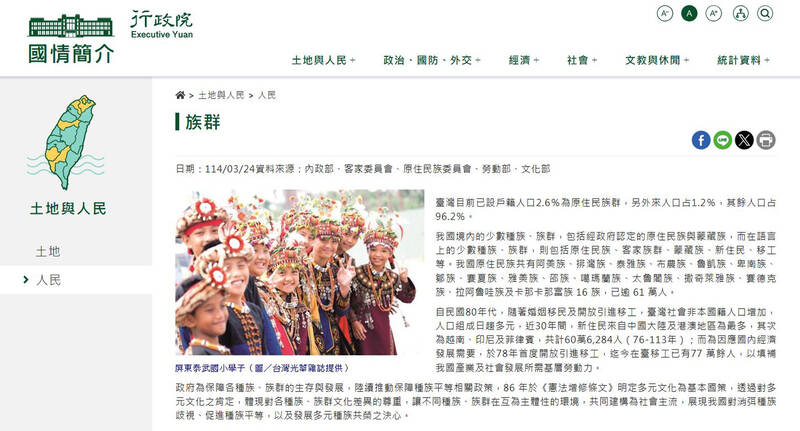The removal of the term “Han Chinese” from the Executive Yuan’s Web site, which has sparked an online backlash, was intended to improve ethnic equality in Taiwan based on advice from the Control Yuan and was not politically motivated, Cabinet spokeswoman Michelle Lee (李慧芝) said on Sunday.
A user on the Professional Technology Temple (PTT) online bulletin board on Saturday wrote that on March 24 a section on the Executive Yuan’s Web site about ethnic groups in Taiwan removed the term “Han Chinese.”
The current version of the site states that indigenous people make up 2.6 percent of registered households in Taiwan, while 1.2 percent were foreign nationals and 96.2 percent were “the rest of the population.”

Photo: screen grab from the Executive Yuan Web site
A screenshot of the site archived on March 17 on the Wayback Machine shows that it previously said that Han Chinese accounted for the largest portion of the population at 96.4 percent.
Soon after the PTT comments gained widespread media attention, the Chinese Nationalist Party (KMT) criticized the change as “cognitive warfare” against China by the ruling Democratic Progressive Party.
KMT Legislator Chen Ching-hui (陳菁徽) on Saturday called the change “absurd,” saying it recognized the ethnicity of minority groups comprising only 3.8 percent of the population, but referred to the 96 percent majority as simply “the rest.”
Such blurring of the nation’s ethnic composition is unhelpful and raises suspicions about the motive behind the change, she said.
Lee said the Department of Household Registration made the revision in response to a suggestion from Control Yuan member Antonio Hong (鴻義章) in December 2022, who said the previous description counterposed Han Chinese against indigenous people and new immigrants.
In the previous language on the site, the term “Han Chinese” encompassed Hoklo and Hakka people, as well as immigrants, Lee cited Hong as saying.
Such polarizing phrasing might hinder efforts to facilitate ethnic equality and eliminate racial discrimination, she cited Hong as saying, adding that he again proposed the revision in 2023.
The Executive Yuan updates the country profile on the Web site annually and uses terms related to ethnicity based on statutes such as the Household Registration Act (戶籍法), the Indigenous Peoples Status Act (原住民身分法) and the Immigration Act (入出國移民法), as well as demographic data, Lee said.
The term “more than 23 million people of Taiwan” refers to citizens of the Republic of China with a registered household, including foreign nationals, she said.
Indigenous people must register their ethnicity in accordance with the Indigenous Peoples Status Act and foreign nationals would be documented as a group based on their first-time household registration, she added.
However, the ethnic status of Hoklo or Hakka people, or minority groups such as Manchus, Mongolians or Tibetans, is not recorded and their numbers could not be calculated by category, Lee said.
As using “Han Chinese” as an umbrella term to encapsulate all these ethnic groups does not accurately reflect their ethnicity, it was replaced with “the rest of the population” to more objectively describe the demographic structure in Taiwan, she said.
The change was not politically motivated and should not be misinterpreted, Lee said.
Additional reporting by CNA

‘WIN-WIN’: The Philippines, and central and eastern European countries are important potential drone cooperation partners, Minister of Foreign Affairs Lin Chia-lung said Minister of Foreign Affairs Lin Chia-lung (林佳龍) in an interview published yesterday confirmed that there are joint ventures between Taiwan and Poland in the drone industry. Lin made the remark in an exclusive interview with the Chinese-language Liberty Times (the Taipei Times’ sister paper). The government-backed Taiwan Excellence Drone International Business Opportunities Alliance and the Polish Chamber of Unmanned Systems on Wednesday last week signed a memorandum of understanding in Poland to develop a “non-China” supply chain for drones and work together on key technologies. Asked if Taiwan prioritized Poland among central and eastern European countries in drone collaboration, Lin

The Chien Feng IV (勁蜂, Mighty Hornet) loitering munition is on track to enter flight tests next month in connection with potential adoption by Taiwanese and US armed forces, a government source said yesterday. The kamikaze drone, which boasts a range of 1,000km, debuted at the Taipei Aerospace and Defense Technology Exhibition in September, the official said on condition of anonymity. The Chungshan Institute of Science and Technology and US-based Kratos Defense jointly developed the platform by leveraging the engine and airframe of the latter’s MQM-178 Firejet target drone, they said. The uncrewed aerial vehicle is designed to utilize an artificial intelligence computer

Renewed border fighting between Thailand and Cambodia showed no signs of abating yesterday, leaving hundreds of thousands of displaced people in both countries living in strained conditions as more flooded into temporary shelters. Reporters on the Thai side of the border heard sounds of outgoing, indirect fire yesterday. About 400,000 people have been evacuated from affected areas in Thailand and about 700 schools closed while fighting was ongoing in four border provinces, said Thai Rear Admiral Surasant Kongsiri, a spokesman for the military. Cambodia evacuated more than 127,000 villagers and closed hundreds of schools, the Thai Ministry of Defense said. Thailand’s military announced that

CABINET APPROVAL: People seeking assisted reproduction must be assessed to determine whether they would be adequate parents, the planned changes say Proposed amendments to the Assisted Reproduction Act (人工生殖法) advanced yesterday by the Executive Yuan would grant married lesbian couples and single women access to legal assisted reproductive services. The proposed revisions are “based on the fundamental principle of respecting women’s reproductive autonomy,” Cabinet spokesperson Michelle Lee (李慧芝) quoted Vice Premier Cheng Li-chiun (鄭麗君), who presided over a Cabinet meeting earlier yesterday, as saying at the briefing. The draft amendment would be submitted to the legislature for review. The Ministry of Health and Welfare, which proposed the amendments, said that experts on children’s rights, gender equality, law and medicine attended cross-disciplinary meetings, adding that